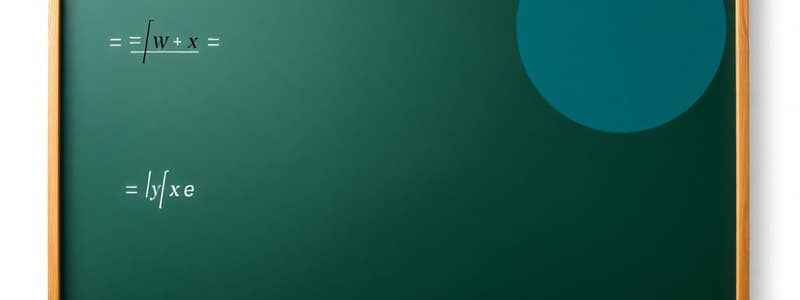Podcast
Questions and Answers
What is a set?
What is a set?
A set is a collection of related and well-defined objects called elements.
A collection of subjects in Grade 10 is a set.
A collection of subjects in Grade 10 is a set.
True (A)
Which of the following is NOT a set?
Which of the following is NOT a set?
- A collection of nice shoes
- A collection of subjects in Grade 10
- A collection of tall buildings (correct)
- A collection of musical instruments
What is the universal set?
What is the universal set?
Which notation is used to represent the set of all even whole numbers between 1 and 10?
Which notation is used to represent the set of all even whole numbers between 1 and 10?
How is set-builder notation represented?
How is set-builder notation represented?
Georg Cantor introduced the word 'set' in _____ .
Georg Cantor introduced the word 'set' in _____ .
What does the symbol ℚ represent?
What does the symbol ℚ represent?
Flashcards are hidden until you start studying
Study Notes
Core Concepts of Sets
- Mathematics has its own unique symbols, syntax, and rules.
- A set is defined as a collection of well-defined and related objects, referred to as elements.
- The symbol for an element belonging to a set is denoted by ∈.
Definitions
- Set: A well-defined collection of objects. Example: {1, 2, 3, 4}.
- Subset: A set where all elements are contained in another set.
- Proper Subset: A subset that does not contain all elements of the parent set.
Notation
- Roster Notation: Lists the members of a set separated by commas. Example: {2, 4, 6, 8} for even whole numbers between 1 and 10.
- Set-Builder Notation: Describes the properties that elements must satisfy. Example: {x ∈ ℕ | 0 < x < 5} indicates natural numbers greater than zero but less than five.
Types of Sets
- Universal Set (U): Contains all elements of interest, including all subsets. Denoted often by U.
- Common Symbols:
- ℝ: Real numbers
- ℤ: Integers
- ℕ: Natural numbers
- ℚ: Rational numbers
- ℤ⁺: Positive integers
- ℝ⁺: Positive real numbers
Set Operations
- Ability to perform operations like union, intersection, and difference on sets.
- All possible subsets of a given set can be derived, showing various groupings of elements.
Visual Representations
- Venn Diagrams: Used to illustrate subsets and universal sets visually. Helps in understanding relationships between different sets.
Historical Context
- The concept of a "set" was introduced by mathematician Georg Cantor in 1879.
Studying That Suits You
Use AI to generate personalized quizzes and flashcards to suit your learning preferences.



